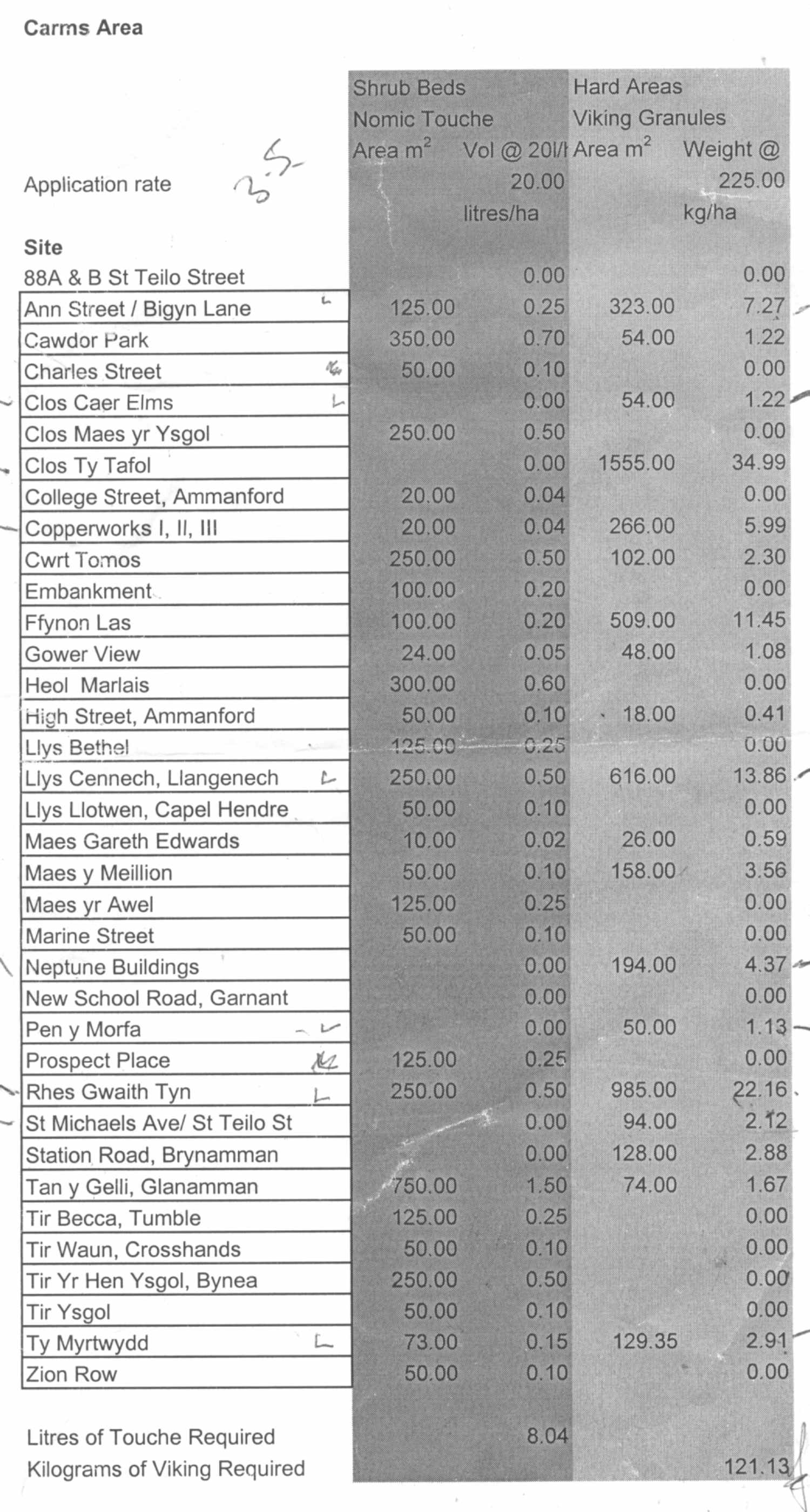Diary
Home
Appeal
Career
Pesticide
Environment
Kevin Petters

I have been busy the last couple of weeks sorting out my chattels to get rid of unneeded paperwork etc (we have to leave our home as it came with the job) during this tedious process I came across the list we had for spraying.
I had not really studied it before now, I only went to about three of the sites, so I do not know if they all have been sprayed
What is obvious from the list,
is that it proves, that only
hard areas, are to be covered with the granules.
What is now very obvious, is why Chris Williams looked worried and perplexed, and dared question John Bowden about the quantity to be put down at "Clos Ty Tafol".
It is a small site, the first one I think we sprayed.
34.99kg of granules, no wonder there was so much of it blowing around two weeks later!
.

I have bought some rice and sugar,
to try and give a graphic example of the quantities of dangerous pesticide, put down on the road and parking areas at Clos ty Tafol.
On the right of the picture is 3.5 Kg of sugar, I believe, we would have put down if senior management had not got their figures wrong.
On the left is 35 Kg of rice, the actual quantity put down directly on to the hard surfaces.
This massive quantity, was put down despite Chris Williams's concerns that the figures given to him by John Bowden seemed excessive!
The safest person there was a protected Chris, the rest of us were pushing mowers over the area whilst it was being sprayed!
The granules were also being blown everywhere by the person using the blower at the end of the job.
Did Rob Stimpson get the decimal point in the wrong place in his calculations?
We had no sketch or plan of where to spray.
John Bowden was unaproachable and in, ourline management. you dare not by pass the next tier of command.
It was a shambles.
I feel it is important that where we sprayed should be common knowledge, and tenants notified because:
The granules should not have been put down on a hard area, also the quantities put down does not appear to equate to the size of the sites, as can be seen above.
We do not know the long term effects of Dichlobenil to humans.
The effects of this pestcide may not appear in animals, children or adults for a few years. So the local medical centres should be notified.
Another worry is that The Swansea team were spraying their sites, are their figures correct,
will a list of their sites be available, for public scrutiny?
The Carm's team poured over 100kg (2 hundredweights) on to HARD SURFACES, mostly in the Llanelli Area.
How much did the SWANSEA TEAM spread?
SOMETHING SHOULD BE DONE
Some Links
HEALTH HAZARDS OF PESTICIDES
"Late in the afternoon of April 1, 1990, a three-year-old girl playing in front of her trailer home in California�s San Joaquin Valley suddenly lost control of her body and began foaming at the mouth. By the time the girl arrived at the local emergency room, she was near death. She recovered eventually. A report filed with the California Department of Pesticide Regulation concluded the child had been poisoned by aldicarb, a highly toxic insecticide that works the same way on people as it does on bugs -- like nerve gas. �Somebody had parked a tractor with pesticide material on it right in front of the play area,� said Michael O�Malley, the author of the report and a physician at the University of California, Davis."
http://www.nrdc.org/health/kids/farm/chap1.asp
-- Matt Crenson, Associated Press, December 9, 1997
Michael Meacher
http://politics.guardian.co.uk/comment/story/0,9115,1531872,00.htmlGeorgina Downs
http://www.pesticidescampaign.co.uk/.
Martyrs of Pesticide Poisoning
http://www.getipm.com/our-loved-ones/memorium.htm
DICHLOBENIL
The herbicide dichlobenil is used to kill unwanted weeds in shrub beds, orchards, and berry fields.
It is “among the most toxic chemicals hitherto reported” to nasal tissue. Damage to this tissue reduces
smelling ability and the transport of an important amino acid to the brain.
Dichlobenil affects reproduction in both male and female animals. In male hamsters, long-term feeding studies
found that ingestion of dichlobenil decreases the weight of the testes, decreases the number of sperm stored
in reproductive organs, and causes degeneration of the prostate gland. In female rabbits, ingestion of
dichlobenil resulted in an increase in the number of unsuccessful pregnancies. The frequency of cleft palate, a
birth defect, in their offspring was increased.
Dichlobenil has caused cancer in three species of laboratory animals. In rats (both sexes) and male hamsters,
long-term feeding of dichlobenil caused an increase in the frequency of liver tumors and cancers. Injection of
mice with small amounts of dichlobenil caused an increase in the frequency of lymphoma.
Dichlobenil is “remarkably persistent” in soil and residues have been measured five years after application. It
volatilizes (vaporizes) readily so it can contaminate air in areas where it is used.
Dichlobenil is acutely toxic to fish, bioconcentrates in fish tissues, and reduces their reproductive success.
Dichlobenil reduces the growth of beneficial mycorrhizal fungi on the roots of apple trees.